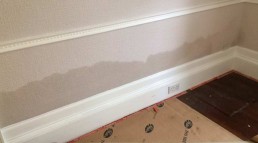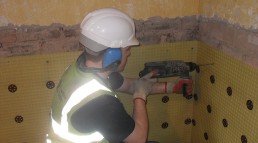Dealing with a damp property? We understand that this can be frustrating – and while you can try to ignore it, the problem will not go away. Worse still, if ignored it can grow into an even more expansive problem and result in rot affecting your structural timbers such as floor joists.
This short guide will answer all key questions about rising damp, including what it is, what causes it, the signs to look out for, and how to treat it effectively.
Read on to learn more about rising damp – and how to tackle it or visit our Rising Damp FAQ page.
What is Rising Damp – and What Causes it?
Rising damp is a form of damp that affects buildings and occurs due to damp in the ground rising through the fabric of your property walls.
It does not matter whether your wall is brick or stone; damp can still travel upwards due to capillary action. Capillarity is a phenomenon where moisture is sucked through microscopic pores within the wall fabric, tube-like holes, causing the fabric to draw the dampness into it, just like a sponge.
The damp is always in the ground at varying levels – and this is okay if the damp proof course does its job. The damp proof course (DPC) can become damaged or deteriorate over time, and therefore may need to be repaired renewed.

Rising Damp: What are the Signs to Look out for?
Rising damp can showcase a list of symptoms that are also common to other damp problems such as penetrating damp. The most important identifier for rising damp is that it affects the lower section of the wall and rarely affects the wall fabric further than 1 metre above the ground level.

Here are the most common signs suggesting that you may have a rising damp problem:
- The wall has a high moisture content and might be damp to touch
- The wall might display damp stains appearing in the form of tide marks
- The damp stain might be covered with salt deposits
- Flaky paint
- Peeling wallpaper
- Crumbling or bubbly plaster
- Crumbling mortar between bricks or stonework
- Rotting skirting boards or floorboards
- Rusting steel and iron fasteners
One additional sign identifying a damp problem is a damp, musty odour appearing in the room. While this does not necessarily indicate a rising damp problem, it does indicate that your property is affected by damp.
What you probably want to know is that damp can be treated. It is vital to get a professional diagnosis from a qualified surveyor, who can provide a thorough survey of the property and specify the most effective solution to make your property dry again.
Rising Damp: How to Treat it?
If you are dealing with dampness in your property, it is important to treat it as soon as possible. After all, as is the case with many forms of damp, rising damp can escalate and prove to be a costlier problem, such as causing dry or wet rot to affect structural timbers later down the line.
Before rising damp treatment can commence, a surveyor will carry out a survey, which allows us to ensure we are taking the correct action. Only when we know the scale of the problem as well as what needs to be done, our technicians will carry out the necessary remedial work to tackle your damp issue.
Depending on the site conditions of the property itself, we will need to either repair the existing damp proof course or install a brand-new damp proofing system. These systems typically comprise a combination of installing a remedial DPC and a damp proofing membrane application. Together, these two damp proofing methods create a solution to your problem that will be guaranteed to work for at least 30 years.

Rising Damp Treatment
A chemical damp proof course (DPC) can deal with dampness by forming a continuous unbroken layer of waterproofing material to create a barrier to damp rising up the wall from the ground.
First, the damp affected plasterwork must be stripped to remove the salt contaminated area. Once the wall is exposed, our preservation technicians drill a series of holes into the base the wall, before injecting the waterproofing material.
In addition, the area may require to be covered with a cavity wall membrane system prior to plastering the area again; what this does is prevent any visible interior penetration from residual damp in the wall and stops salt migration, which will allow the wall to dry out quicker without affecting the new plaster.
You can be sure that we will consider everything from the type of property construction and any contributory site issues before we ascertain the most appropriate rising damp treatment specification for your property. On top of that, we will always ensure we walk you through any work we undertake – and at every stage of the project – and our team will leave your property clean and safe.
Rising Damp: What to do Next?
If you suspect you have rising damp in your property, do not hesitate to contact us for advice.
A specialist surveyor from your local branch will survey your property and provide a cost-effective specification for repairs. Once the repair quotation is accepted by you, our experienced preservation technicians will carry out damp proofing works and leave your property clean and safe. In addition, our rising damp treatments are supported with a 30-year transferable guarantee, meaning that the GPI protected guarantee remains valid even when the property is sold. Contact your local branch for free advice or to arrange a property survey.